|
BLUB LOG 02 12th January 2005
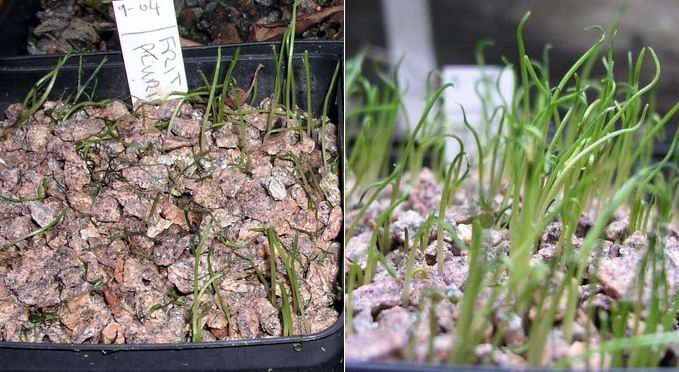
Frit pluriflora seedlings
I showed a good crop of Frit. pluriflora seedlings in the last log of 2004: fortune has not smiled upon them but rather snow and freezing conditions - you can see the resulting loss. To the right is the December picture and the picture to the left shows that only a few have survived the freezing conditions. I had not noticed that they had germinated so failed to get them under cover and they were both frozen and battered by the snow - a pretty brutal introduction to life. I hope that with care I will rescue those that have survived and so I will not have lost everything. There is also the hope that the survivors will be the hardier, tougher individuals more suited to our cold weather. I always believe that when you raise bulbs from seed it is the plants that select you rather than the other way around. Those that do not like your horticulture and climate die out at an early age and those that you manage to raise to flowering size have adapted to your conditions and should thrive.
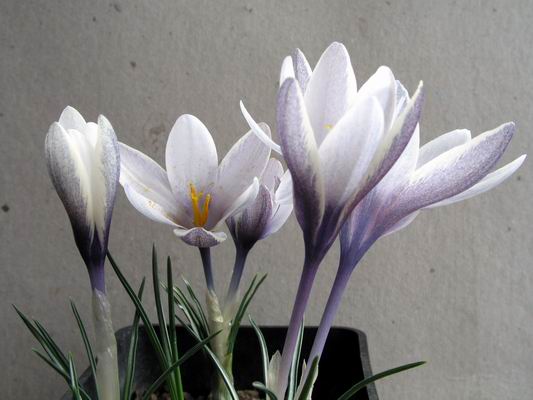
Crocus michelsonii
This beautiful desirable and expensive creature is the much sought after Crocus michelsonii. Closely related to C. alatavicus and C. korolkowii, these three species make up a small section that also happens to be the most eastern of the crocuses in the wild. Crocus michelsonii occurs in Iran and Central Asiatic Russia and was introduced into cultivation in the mid 1960's. Above is a pot of seedlings some flowering for the first time.
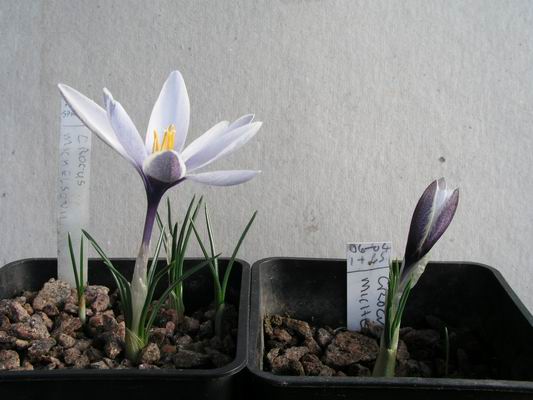
Crocus michelsonii compared
We have grown this crocus for a number of years as a single surviving seedling from three original seeds we received. This original bulb, above right, has never produced any offsets and only occasionally sets some seeds, so increase has been slow. Now we have another two pots of seedlings that have reached flowering size: the one to the left above is from seed we received from a good friend plus the pot in the previous picture.
With these other clones now flowering I have been cross pollinating with the paint brush and I have high hopes of a better seed crop so we can look forward to a greater increase in stocks even if we have to wait for the seedlings to mature. To help this process of fertilisation we have had these pots in our kitchen, for the last few days, where the warmth opens the flowers and helps the pollen grow down to fertilise the embryo seeds in the ovaries.
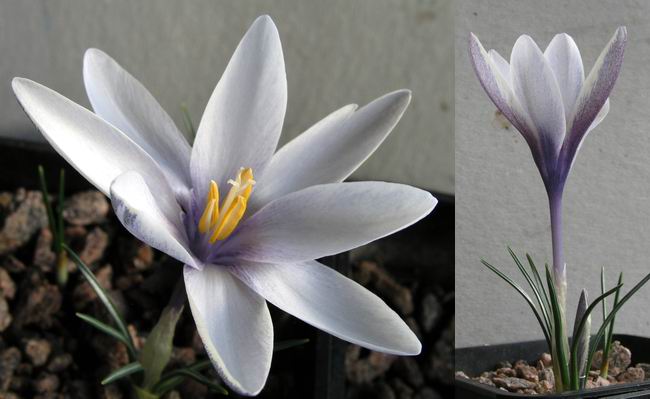
Extra petals
The close up, above, shows that one of the flowers has extra segments with eight tepals instead of six. This mutation is rarely genetic and the second flower that arose from the same corm had only the regulation six perianth segments.
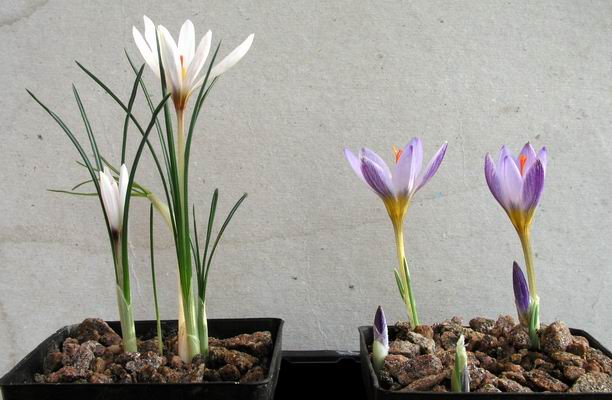
Crocus fleischeri & biflorus
The next two crocus to flower this year are Crocus fleischeri & biflorus; this picture reveals their size difference.
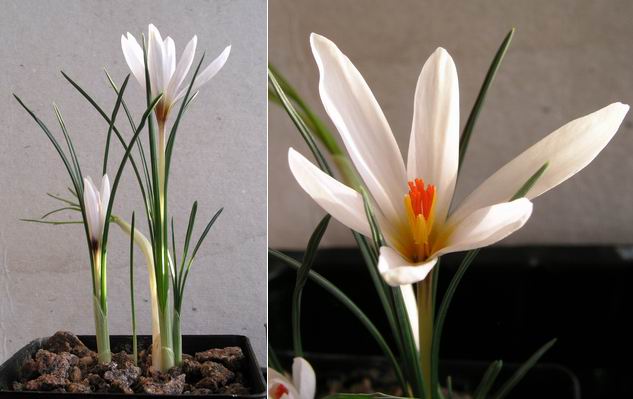
Crocus fleischeri
Crocus fleischeri, from Turkey, has a tall elegance with its starry white flowers and that contrasting orange style. It is another species that is slow to increase vegetatively and we mostly rely on seed.

Crocus biflorus ssp taurii
Crocus biflorus is one of the most variable species and has given rise to a whole host of named cultivars and hybrids in cultivation. Sub species taurii is not the most beautiful of the biflorus conglomerate but I like the shape of them and their deep yellow throat. In contrast to the previous two, this crocus does increase well by offsets.
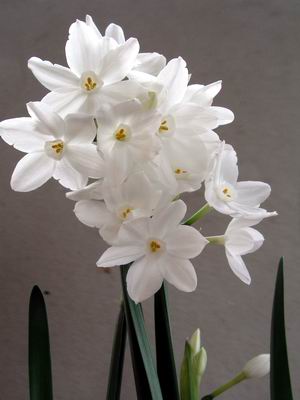
Narcissus papyraceus
We grow Narcissus papyraceus, the paper white narcissus, as an annual, choosing to buy new bulbs each year rather than trying to grow the bulbs on to re-flower every year. We have tried to keep the bulbs in the past and we can keep them going and every year we got a nice crop of leaves but we never managed to get flowers- we are just too far north. We like them as a house plant for the fantastic scent they give off especially in the evening, not to mention their stunning simple beauty.
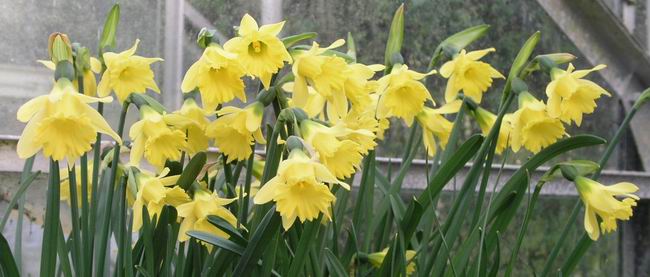
Narcissus 'Cedric Morris'
Narcissus Cedric Morris' is no hot-house flower and has featured often on the bulb log. This should be no surprise as the flowers just keep on going; it has to be the longest flowering of all the narcissus that we grow. This may be partly to do with the fact that they are not very fertile, I have never heard of it having set seed, and so the flower remains fresh looking, ever hopeful, for months.
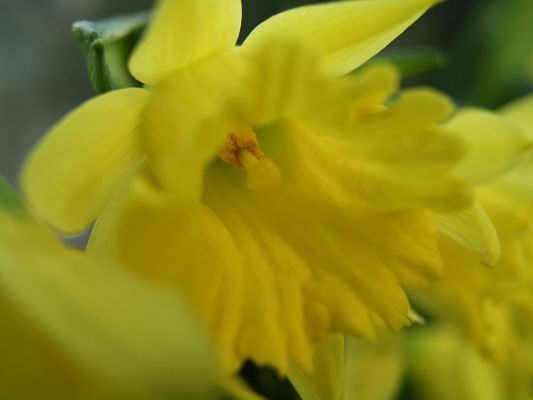
Cedric Morris close-up
And now for the artistic close up. The colour seems to be an acceptable replacement for the lack of sunshine in the Northern winter and recharges my internal batteries.
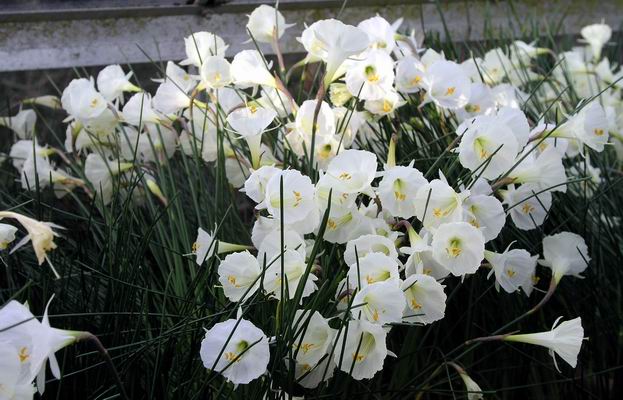
Narcissus Sea
The winter is always made shorter by the sea of 'Hoop Petticoat' Narcissus flowers that start as early as October and flower until April with N. bulbicodium sometimes still flowering in June. It is mostly forms and hybrids of Narcissus romieuxii that predominate in deepest winter. There has been some discussion in the forum lately about some of the naming of these plants and it is very confused in that few people around remember the first plants that came out under a name. As these floriferous little bulbs are also very promiscuous, and seedlings get everywhere, it is all too obvious to see how this sort of confusion and mix up takes place especially as they, unlike Crocus michelsonii , also increase well vegetatively. The good thing is that even if we cannot say for sure what their real name is we can enjoy the variation that we can see.
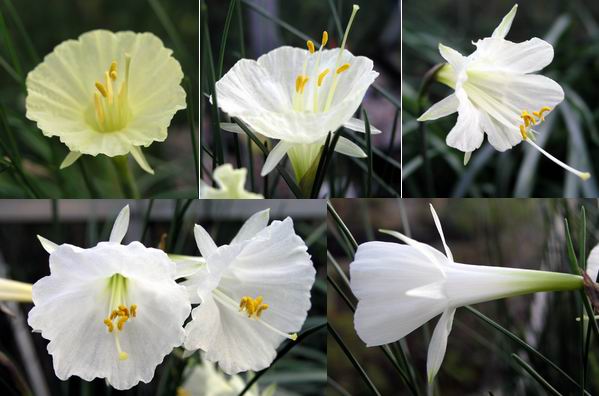
Narcissus montage
This is just a selection of forms and hybrids of N. romieuxii, and N. cantabricus (bottom right) which you can see has a distinctly different shape to the tube. A little used diagnostic between N. cantabricus and N. romieuxii is scent. All forms of N. cantabricus that I have come across have a strong sweet scent while N. romieuxii has virtually no scent except a slight hint of what I call a 'green scent'. Hybrids between these two have a very slight sweet scent indicating the relationship with N. cantabricus.
^ back to the top ^
|

